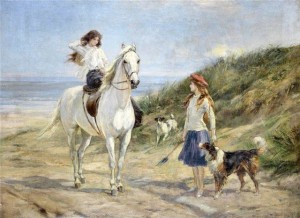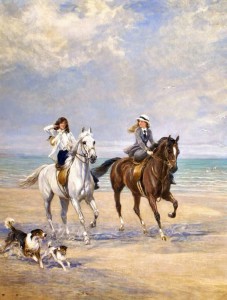Heywood Hardy for Thursday Art Day

The first paintings I found by Heywood Hardy were mainly hunting and carriage driving and coaching scenes. While I admired these painting it was when I came across the subjects of people and children out and about meeting friends, pondering life and enjoying a ride along the beach that made me sit up and take notice. I agree with Sally Mitchell (The Dictionary of British Equestrian Artists) words when she stated that Hardy had a great eye for a horse. His horses are animated and interactive with pricked ears, wonderfully expressive, large eyes and faces that appeared to be actually interested in their surroundings. His horses are the type we’d all love to own, upstanding and proud with a classic Thoroughbred look about them.
It’s been written that he was often invited to country estates to paint portraits, sporting pictures and animal studies. He also provided illustrations for magazines such as the Illustrated London News, and The Graphic, as well as producing etchings of his work.
Exhibited: Royal Society of British Artists, Suffolk Street (1863 to 1871); Royal Academy (46 paintings between 1864 and 1919); The British Institute; The Old Watercolour Society.
Heywood Hardy ARWS, RE, ROI
(1842 – 1933)
A painter of equestrian, hunting and genre scenes often set in the eighteenth century, as well as a distinguished portraitist, Heywood Hardy was the youngest son of the artist James Hardy Snr (1801-1879).
He began his career as an animal artist in Keynsham; however, following initial failure, he joined the 7th Somerset Volunteers for a brief period. In 1864, Hardy went to Paris and entered the Ecole des Beaux-Arts, where he studied with the battle painter, Pielse. He then visited Antwerp, returning to England shortly before 1868.
In 1870, Hardy settled in London and shared a studio with Briton Riviere. His career flourished and he was elected a member of several societies, including the Royal Society of Painters and Etchers, the Royal Institute of Oil Painters and the Royal Society of Portrait Painters. He was an Associate of the Royal Watercolour Society. Hardy also worked as an illustrator, contributing to The Illustrated London News and The Graphic Magazine.
Famed for his sensitive portrayal of animals, Hardy was invited to many country estates
and commissioned by several distinguished patrons, including Colonel Wyndham Murray,
the Marquis of Zetland and the Sitwells of Renishaw.
Hardy moved to West Sussex in 1909, and at the age of eighty-three embarked upon a
unique phase in his career. This was a controversial series of biblical scenes portraying
Christ walking in the Sussex countryside, surrounded by recognisable contemporary
village dignitaries. These panels were painted to mark the 700th anniversary of Clymping
Church, where they can still be seen today.

Leave a Reply